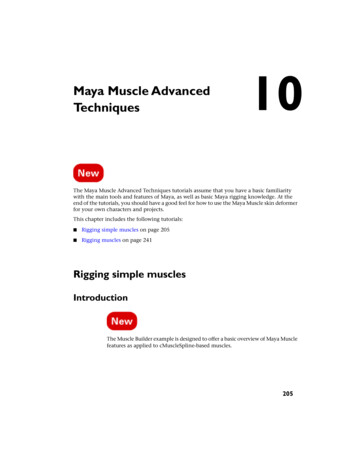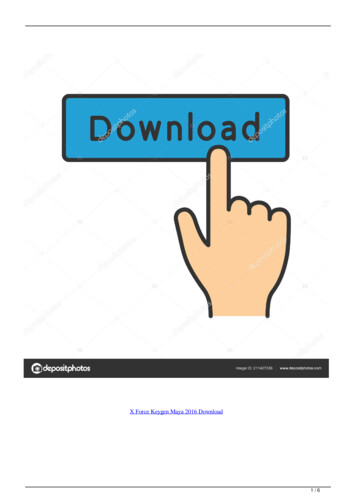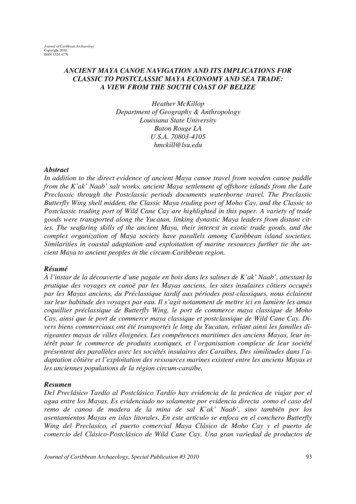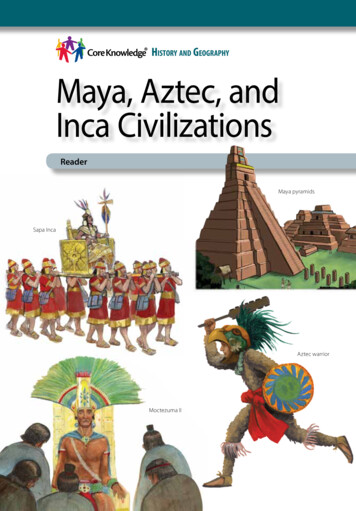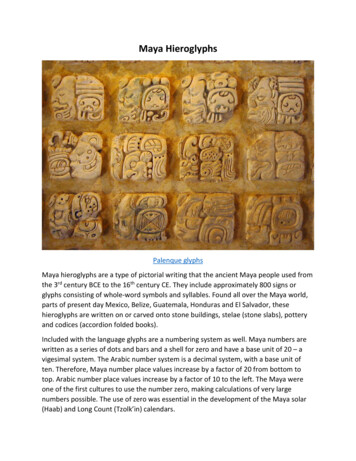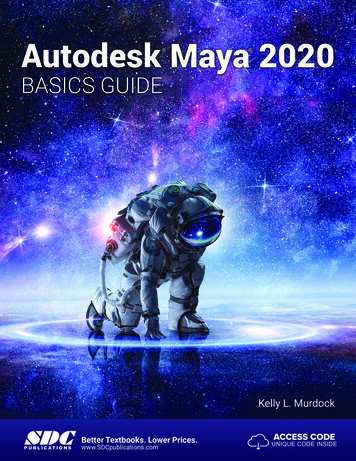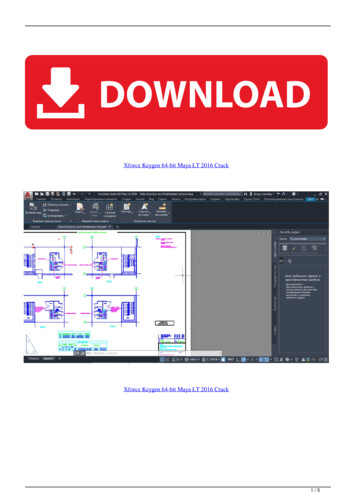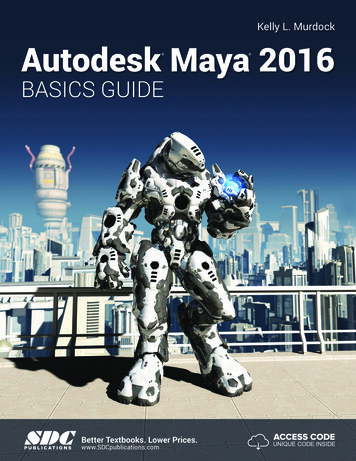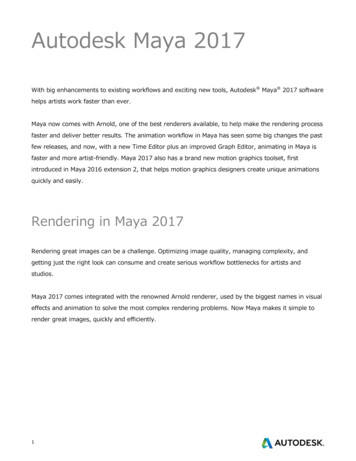
Transcription
Autodesk Maya 2017With big enhancements to existing workflows and exciting new tools, Autodesk Maya 2017 softwarehelps artists work faster than ever.Maya now comes with Arnold, one of the best renderers available, to help make the rendering processfaster and deliver better results. The animation workflow in Maya has seen some big changes the pastfew releases, and now, with a new Time Editor plus an improved Graph Editor, animating in Maya isfaster and more artist-friendly. Maya 2017 also has a brand new motion graphics toolset, firstintroduced in Maya 2016 extension 2, that helps motion graphics designers create unique animationsquickly and easily.Rendering in Maya 2017Rendering great images can be a challenge. Optimizing image quality, managing complexity, andgetting just the right look can consume and create serious workflow bottlenecks for artists andstudios.Maya 2017 comes integrated with the renowned Arnold renderer, used by the biggest names in visualeffects and animation to solve the most complex rendering problems. Now Maya makes it simple torender great images, quickly and efficiently.1
Arnold and Maya—better together.Arnold lets you render high-quality images right out of the box, scaling with your processing power asproject complexity demands. And Arnold's sophisticated sampling reduces the number of iterations ittakes to get the perfect result, so artists can spend less time on rendering and more time making art.Maya 2017 comes with improvements to Viewport 2.0 that allow artists to better visualize Arnoldresults, as well as the new Arnold RenderView, which offers fast interactive rendering along with othergreat features. A new sequence-rendering feature allows artists to preview frame sequences right inMaya. And scaling to larger jobs is simple: just add Arnold licenses if you want to render on localresources, or render projects on the cloud using a popular service such as Google Cloud PlatformZYNC Render.Arnold adapts readily to your existing pipeline. You get compositing-friendly rendering, robustrendering features, and ease of use. For technical users, Arnold is fully customizable, with a powerfulAPI for creating custom rendering solutions.With Arnold plus Maya’s Render Setup system, which lets you automate the laborious task of settingup renders within a single window, Maya provides an unparalleled rendering experience. Whether2
you’re working on your latest film or quickly turning around motion graphics projects, it’s easier thanever to create renders, then deliver everything for compositing and finishing—including an industrystandard set of AOV outputs, for example—to achieve great final results.For those using other renderers, Maya remains an open rendering platform of choice, with continuedcollaboration with, and support for, third-party renderers to improve support for new Maya features.The replacement of mental ray with Arnold in Maya changes the way render licenses are handled;please see our mental ray FAQ for more details.Maya for motion graphics. And a whole lotmore.Maya 2017 includes MASH, first introduced in Maya 2016 extension 2. This procedural, node-basedtoolset allows designers and artists to combine nodes to quickly create unique animations and effects.Its intuitive and easy-to-use procedural instancing and animation toolset is ideal for creating complexmotion graphics, UI design, environments, animation, and effects.Improvements to MASH in Maya 2017 make it easier than ever to create complex proceduralanimations and effects. A new UI makes using MASH more intuitive for 3D motion designers andPhotoshop users alike, so it’s simple to add, reorder, and experiment with MASH nodes. New nodesand improved features (including a revamped audio node, which can drive anything in Maya withselectively filtered audio) make MASH faster and easier to use, and enable artists to create brand-neweffects. You also get an improved 3D Type tool, an easy copy-paste workflow for SVG files, a newcurve warp tool, and more.3
In addition, Maya 2017 now includes the Arnold renderer, bringing advanced, film-quality rendering tothe world of motion design. Arnold makes it simple to render all Maya effects, such as hair andvolumes, combining artist-friendly ease of use and customizability with performance that’s robust andstable in even the most complex situations. Motion designers can quickly and interactively renderimages of stunning quality—and produce images with embedded channels, enabling flexible reworkingin compositing applications including Adobe After Effects. Clear, straightforward documentation and apassionate user community make it easy to get started.Finally, Viewport 2.0 in Maya 2017 provides faster performance and greater image fidelity than youget with other 3D tools. Viewport 2.0 gives artists a better understanding of what their final sceneswill look like, without wasting time on preview renders—making it easier than ever to do great workwhile meeting the tight deadlines typical of motion-graphics projects. Viewport 2.0 can also be used asa real-time render engine for design-oriented work.Animation in Maya 20174
Maya 2017 is built for speed, with new, more artist-friendly tools and performance improvements thatmake animating in Maya faster and more intuitive than ever before.You get the supercharged animation performance and accelerated interactive playback and rigmanipulation introduced in Maya 2016, plus new performance enhancements that drive animationproductivity even as character complexity grows.Maya 2017 uses smarter evaluation methods to improve the parallel evaluation mode. For example,playback visibility improvements help animators focus on the important parts of their scenes—andavoid sacrificing performance on less-important parts. Add in a comprehensive suite of diagnosis andintrospection tools, and it’s easy to understand why users find it simpler than ever to animatecharacters in Maya.The new Quick Rig tool lets you rig characters in seconds, making it easier for artists of all levels tobring sophisticated character animation to life. For more technical users, a new custom evaluator APIgives you full control of what’s happening under the hood, allowing you to integrate custom tools intoMaya—and Maya into your pipeline.5
Maya 2017 also includes the new Time Editor, a more flexible and powerful nonlinear animationediting system that replaces Maya software’s Trax editor. Artists can work nondestructively with anykind of motion as they bring scenes to life. Rearrange, remix, and experiment with animation, pose,and audio clips.The Graph Editor has been overhauled for Maya 2017, with a more modern look and feel, cleanercurve display, improved interactivity with many visual elements, and streamlined views for easiercurve organization. A new GPU back end keeps it fast and interactive even when working with manydensely keyed curves. Together, the Time Editor and Graph Editor give you a unified animationexperience that’s faster and easier to use than ever.Finally, Maya 2017’s MASH animation toolset is about more than just motion graphics. MASH’s layerbased UI makes it easy to apply procedural, nondestructive animation effects to practically anythingyou do in Maya, with dynamic drag-and-drop functionality that makes it fun to experiment and iterateuntil you’ve created exactly the right effect. More advanced users can access the nodes directly.Powerful features. Easier than ever to use.Maya 2017 makes it easier than ever to model unique, compelling characters. New shape-authoringtools let you sculpt exactly the right expressions, no matter how subtle or intricate. And new XGenfeatures make it easy to create characters with hair or fur, giving you the ability to groom charactersdirectly in the viewport.Upgrades to the integrated Bifrost toolset make it simple to create amazing fluid effects in Maya 2017,without plug-ins or complex customization. The Bifrost Ocean Simulation System (BOSS) let youcreate more realistic ocean surfaces, including waves, ripples, and wakes. In addition, it’s now easierto set up guided liquid simulations, which let artists control the behavior of liquids. And new viscositycontrols help smooth liquid flow in simulations and create viscous effects like lava or toothpaste.Whether you’re creating an ocean, a glass of beer, or an abstract fluid effect, with Maya you get allthe tools you need.6
UI improvements make Maya 2017 the most user-friendly version to date. Workspaces define theconfiguration of windows and panels, providing more flexibility to reconfigure panel layouts; you canopen, close, and move windows and panels, dragging and dropping to dock and undock, almostanywhere in the interface.A new Content Browser, which replaces the old Visor in Maya, is a one-stop shop for finding content tobuild your scenes—just drag files to the view panel from your Maya projects, local and networkdirectories, and sample libraries. When used with the new Time Editor, Maya’s Content Browsermakes it simple and fast for artists to organize and build out pose- and animation-clip libraries to save,share, and reuse work.Key new features in Maya 2017Bifrost:BOSSThe Bifrost Ocean Simulation System lets you create realistic ocean surfaces with waves, ripples, andwakes. You start with a flat mesh, then layer and mix solvers and influences on top. Each element isindependent of the resolution of the others, and each can be cached separately for faster playback.You can use the resulting deformed mesh directly, or transfer the result to another mesh. You canalso use the cached EXR files as vector displacement maps when rendering.Guided liquid simulationsIt is now easier to set up guided liquid simulations. You can now use a deforming plane or other flatmesh as a guide, instead of using a deforming closed volume as an emitter. In addition, you canrestrict a simulation to specific regions, or simulate a layer on top of the guide for extra splashes.ViscosityYou can set a physically correct value for viscosity on the bifrostLiquidPropertiesContainer node. Thenon–physically correct Scale setting is still available as a velocity-smoothing factor, for faster results insituations where accuracy is not required.7
Liquid churn and curvature channelsNew curvature and churn channels let you see where curvature and churn are being generated in aliquid. When enabled, Bifrost computes curvature and churn values, which you can display as colorchannels in the viewport. That lets you visualize potential locations for foam emission in the liquidbefore adding a foam object. You can also use this information to determine accurate Min Liquid Churnand Min Liquid Curvature values for the foam before simulating.ErosionNew Erosion attributes control how closely a liquid boundary is shrink-wrapped back to the particlepositions. Use these attributes to avoid problems in situations such as still water versus thin flows orenergetic splashing. In turbulent liquids, use Erosion attributes to avoid problems such as fast particles "surfing" aheadof boat wakes, fluid repulsion, particle clumping, and particles climbing near the walls of colliders.Erosion settings can also help achieve equilibrium in still-water situations.Motion fieldsYou can now influence particle velocity directly using Motion Fields: Activate and control various components, including Drag and Turbulence, individually. Transform the field property in space. Note that the field's scaling affects its magnitude by default. Select a Boundary Shape to restrict an effect to a specific volume with an optional falloff, or simplyto alter the axis used by the options Along Axis, Around Axis, and Away From Axis.Kill fieldsUse kill fields to delete unwanted liquid, foam, or aero particles in a Bifrost simulation. Affect particlesbased on specified criteria when the particles are within a specific volume.UI:WorkspacesWorkspaces define the configuration of windows and panels. You can modify a workspace by opening,closing, and moving windows and panels, or dock or undock them by dragging and dropping. Thesechanges are automatically saved as overrides to your current workspace.8
Workspaces are more flexible than panel layouts because you can move or dock almost any window orpanel almost anywhere in the interface. Workspaces are stored as separate files in your user directoryinstead of in scenes.New Content BrowserThe new Content Browser replaces the Visor, serving as your one-stop center for examples, scenes,and other content used to build in Maya. Navigate for files in your Maya projects, local and networkdirectories, and sample libraries, then drag and drop them into the view panel.Animation:Graph EditorThe Graph Editor, the backbone of the animation workflow, has a new, more intuitive interfacedesigned to streamline the animation process.The redesigned Graph Editor puts the emphasis on curve visibility—increasing contrast between curvesand background, simplifying the stacked view, and moving the timeline to the top of the Graph Editor.Time EditorThe Time Editor is a nondestructive, clip-based nonlinear editor for high-level animation editing.Unlike the Trax Editor, which requires Character Sets, the Time Editor frees animators to work on anyattribute with animation curves, including characters, cameras, and colors. Easily edit pre-existinganimation, including motion capture (even multitake FBX files) and keyframe motion, with intuitivetrim, scale, loop, split, group, and crossfade controls.The Time Editor also lets you edit audio with clip-based workflows based on standard audio mixingsoftware, so you can mix animations to create brand-new motion.Performance improvements:Evaluation ToolkitThe Evaluation Toolkit is a new set of inspection and debugging tools designed to help diagnose scenecorrectness and performance issues. It’s a reworking of the previous Evaluation Manager Debugging9
Shelf (previously available as a Maya shelf and distributed with the Bonus Tools). Making these toolsdirectly available in Maya (Windows General Editors Evaluation Toolkit) offers access to anyonewho wants to understand the implications of new evaluation modes.Use the Evaluation Toolkit to speed up animation, with features that let you manipulate all aspects ofthe Evaluation Manager, including enabling debugging modes and output.Modeling:Interactive hair grooming (XGen)Grooming all types of hair and fur in XGen is easier and faster with Interactive Groom Splines. Newintuitive brush-based tools provide greater control and accuracy for styling and posing hair and fur.XGen also lets you create new Maya-based description, hair sculpting, and modifier nodes to adjustgrooms. Use the Sculpt modifier layers to blend, layer, or key effects created by the interactivegrooming tools. Other interactive grooming modifiers provide additional options for shaping hairs andenable you to animate or simulate hair grooms.These nodes compute on your system's graphics processing unit (GPU), making brush strokes appearin real time—and providing an interactive workflow that requires no disruptive preview generation. Allinteractive groom spline data is saved to Maya scene files without use of additional Ptex or XPDsidecar files.Shape AuthoringShape Editor improvementsA number of improvements have been made to Shape authoring workflows in the Shape Editor,including: You can now merge multiple targets on the same blend shape. In-between targets now have a visibility toggle button; you can target shapes so you can show andhide their effects on a mesh. When creating combination shapes via the Shape Editor, you can now choose the method by whichthe driver targets affect them.10
Note: The Shape Editor was introduced in Maya 2016 Extension 2. The new Shape Editor replaces theBlend Shape Editor as the place to create, edit, and manage shapes. New features include soloing,grouping, mirroring, flipping, duplicating, and importing and exporting shapes.Vertex ID transfer You can modify and transfer vertex orders. You can now change the order of vertices on a polygon object using the Reorder Vertices orTransfer Vertex order commands.Rendering:Arnold for MayaMaya 2017 now includes Arnold for Maya. This plug-in is autoloaded, and Arnold is set as thepreferred renderer in Maya. For a list of new features, see Arnold for Maya new features. Arnold for Maya User GuideImprovements to Render SetupNew Render Setup features: Hierarchical collections are now supported in the Render setup system, improving performance andallowing for better organization and control. It’s easier to recognize objects and nodes that haveoverrides applied, and more advanced workflows are now possible. Lights are added to render layers by default. It’s no longer necessary to drag and drop a lightscollection to add it to a layer. You can create AOV overrides to enable or disable different AOVs on each render layer, or exportyour AOVs and import them into another scene. You can batch render scene files with either render setup or legacy render layers, without having toswitch the Preferred Render Setup System in your Maya preferences.Note: Maya's Render Setup system was introduced in Maya 2016 Extension 2. It replaces the legacyrender layer system, simplifying management of complex scenes. It brings a modern approach toadding shot-based overrides to scenes, letting you easily generate shot setup templates andpropagate then from one shot to another.11
Sequence rendering in UIYou can now render a sequence of frames interactively.You can render a sequence of animation frames without batch rendering. For convenience, you canalso add these images to the Render View for preview.Displacement preview for animators and OSD native in VP2Use the Adaptive method in Viewport 2.0 to display the results of a displacement map, giving you abetter sense of how it will look in your final render.Hair object in Hypershade material viewerYou can now render your hair shader using hair swatch geometry in the Material Viewer inthe Hypershade.OCIO look support for color managementMaya 2017 includes multiple improvements and fixes for color management.The OpenColorIO environment variables OCIO ACTIVE DISPLAYS and OCIO ACTIVE VIEWS aresupported.Maya 2017 also supports Academy/ASC Common LUT format files (.clf). These can be added as usercolor transforms for input, viewing, or output.Color picking now works properly in the UV Editor. Color values are returned in the rendering space,without the effects of either the View Transform or the Exposure and Gamma settings.Motion graphics:MASH improvementsThe MASH Toolkit has undergone a number of improvements, including to theMASH menu and Workspace.MASH now has its own menu, which you can find in the Animation and FX menu sets. EverythingMASH-related that used to be accessible via the Create menu is now found here.12
You can also access MASH functions from the new MASH and Motion Graphics workspaces.MASH EditorThe new MASH Editor is designed to help you manage the MASH networks in your scenes. From hereyou can select individual networks, rename or delete them, add nodes, enable/disable nodes, andreorder nodes to change their cumulative effect on the network.Improved channel handlingYou no longer need to apply certain nodes to specific attribute channels. Instead, all nodes now affectall appropriate channels simultaneously. For example, where you previously had to create a Noisenode for a network's translation and scale independently (either in local or world space), a single Noisenode controls both functions.Additionally, all nodes now have a single incoming and outgoing connection. This greatly reduces theamount of clutter in the Graph Editor.Note: Networks created in previous versions of MASH will retain their old functionality and nodeinterfaces but will be bridged using an additional Legacy conversion node.New node: BreakoutA new Breakout node replaces the old script-based method of extracting information fromMASH networks.New node: SignalA new Signal node combines and expands on the functionality of the old Noise and Trig nodes. It canaffect the Translate, Rotate, and Scale channels simultaneously.New node: StrengthA new Strength node replaces and expands on the functionality of the old Mute node. It can affect theTranslate, Rotate, and Scale channels simultaneously.13
Color node: UV Mesh mappingA new UV Mesh slot has been added to the Color node, which assigns a mesh's UVs to a MASHnetwork to help color its primitives.Distribute node enhancementsThe Distribute node has a number of new and improved features, including: Support for Face and Edge selection sets, in addition to Vertex selection sets A new Paint Effects distribution mode Support for viewing wireframes of connected meshesFlight node: enhanced steeringNew attributes in the Flight node allow points to orient themselves to their current flight directionautomatically. (Previously, this required attaching an extra Orient node.)Trails node: color channel compatibilityTrails are now connected to the color channel. Select the Trails node and enable vertex coloring if youwant trails to inherit the colors of any attached Color node.Time node enhancementsA Random Time Scale attribute has been added to the Time node, allowing you to randomly scale theanimation loop length per particle. Also, this node is no longer added automatically when you create aMASH network with the Mesh Geometry Type.Audio node: improved functionalityThe Audio node has a number of new and improved features, including: A new Smoothing attribute, which you can use to smooth out jitteriness A new Filtering attribute to reduce the severity of sudden amplitude changes A new Fourier Scaling option, which you can use to exaggerate amplitudesNode performance enhancementsThe Explode, Flight, Random, Symmetry, and Transform nodes have been optimized for fasterperformance.14
New Create MASH Network optionsYou can now assign default naming and distributions for the MASH network creation process, or youcan force Maya to prompt for a new name at network creation. Features include: New UINew nodes for more FX Nodes support multiple channels Connectivity: new breakout node, Color supports UV mapping, Paint FX distribution node Audio enhancements: frequency selection and adjustment, audio falloff node Integrated physical rendererFor a full list of features included in Maya 2017, visit What’s New in Maya.Autodesk, the Autodesk logo, and Maya are registered trademarks of Autodesk, Inc., and/or its subsidiaries and/or affiliates inthe USA and/or other countries. All other brand names, product names, and trademarks belong to their respective holders.Autodesk reserves the right to alter product and services offerings, and specifications and pricing, at any time without notices,and is not responsible for typographical or graphical errors that may appear in this document. 2016 Autodesk, Inc. All rightsreserved.15
Autodesk Maya 2017 With big enhancements to existing workflows and exciting new tools, Autodesk Maya 2017 software helps artists work faster than ever. Maya now comes with Ar
